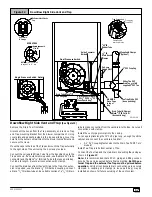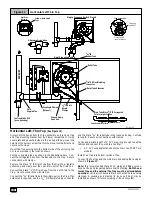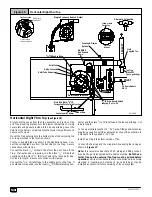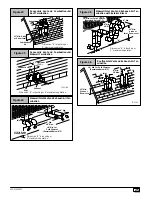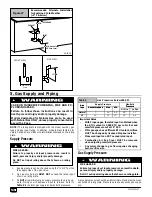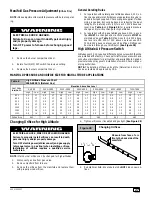
24
440 01 2020 01
!
Maintain a minimum of 36
²
between combustion air inlet
and clothes dryer vent. Terminate the combustion air
intake as far as possible from any air conditioner, heat
pump, swimming pool, swimming pool pumping,
chlorinator or filtration unit.
CAUTION
CARBON MONOXIDE POISONING HAZARD.
Failure to properly vent this furnace can result in death,
personal injury and/or property damage.
!
1. Install all couplings, nipples and elbows using proper proce-
dures for
Joining Pipe and Fittings
and maintain spacing
between vent and combustion air piping as indicated in
Figure 19
through
Figure 26
.
8” *MIN.
20’ MAX
Figure 19
Sidewall Termination 12
²
or More
Above Snow Level or Grade Level
*18, Minimum for cold climates
(substained below 05 F)
Horizontal Termination
1. Cut two holes. 2
1
/
2
²
for 2
²
pipe, 3
²
for 2
1
/
2
²
pipe, or 3
1
/
2
²
for
3
²
pipe. Do
NOT
make the holes oversized, or it will be nec-
essary to add a sheet metal or plywood plate on the outside
with the correct size hole in it.
2. Check hole sizes by making sure it is smaller than the cou-
plings or elbows that will be installed on the outside. The
couplings or elbows
MUST
prevent the pipe from being
pushed back through the wall.
3. Extend vent pipe and combustion air pipe through the wall
3
/
4
²
to 1
²
and seal area between pipe and wall.
4. Install the couplings, nipple and termination elbows as
shown and maintain spacing between vent and combustion
air piping as indicated in
Figure 19
and
Figure 20
.
A metal shield is recommended 18
²
x 18
²
min. or 18
²
min. diameter
around the vent termination at the exterior wall to protect the house
exterior materials from flue product or condensation (freezing)
damage.
Using Exterior Risers
1. Install elbows and pipe to form riser as shown in
Figure 20
.
2. Secure vent pipe to wall with galvanized strap or other rust
resistant material to restrain pipe from moving.
3. Insulate pipe with Armaflex or equivalent moisture resistant
closed cell foam insulation or Fiberglass insulation if boxed
in and sealed against moisture.
8” * MIN.
20’ MAX
Figure 20
Sidewall Termination with Exterior
Risers to Get Above Snow Level or Grade
Level
*18, Minimum for cold climates
(substained below 05 F)
Vertical Termination
1.
Figure 21
shows the proper installation and clearances for
vertical vent termination. The vertical roof termination
should be sealed with a plumbing roof boot or equivalent
flashing. The inlet of the intake pipe and end of the exhaust
vent must be terminated no less than 12
²
above the roof or
snow accumulation level, and 12
²
away from a vertical wall
or other protrusion.
2. If the vent system is installed in an existing chimney make
sure clearances shown in
Figure 21
are maintained. Hori-
zontal section before the termination elbow can be extended
on the inlet air to provide necessary clearance.
Figure 21
Rooftop Termination
25--00--06
A
A
B
A = 12
²
Above roof or snow accumulation level
B = 8
²
Min., 20
¢
Maximum, except in areas with extreme
cold temperatures (sustained below 0
°
F), the 18
²
Min.
Vent Termination Shielding
Under certain wind conditions some building materials may be af-
fected by flue products expelled in close proximity to unprotected
surfaces. Sealing or shielding of the exposed surfaces with a corro-
sion resistant material (such as aluminum sheeting) may be re-
quired to prevent staining or deterioration. The protective material
should be attached and sealed (if necessary) to the building before
attaching the vent terminal.
Multi Vent Termination Clearances
When two (2) or more furnaces are vented near each other, each
furnace must be individually vented.
Two (2) vent terminations may be installed as shown in
Figure 22,
Figure 23, Figure 24, Figure 25, Figure 26 and Figure 27
, but
the next vent termination must be at least 36
²
away from first 2 ter-
minations. It is important that vent terminations be made as shown
to avoid recirculation of flue gases.
Summary of Contents for 9MPT050F12A
Page 46: ...46 440 01 2020 01...








